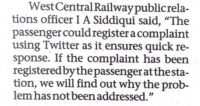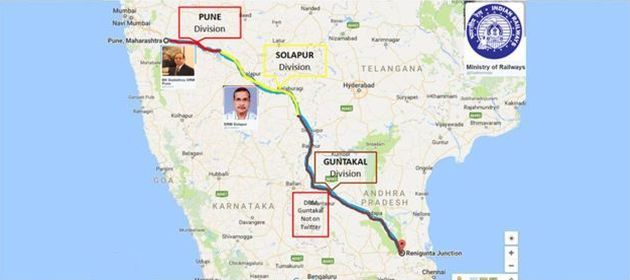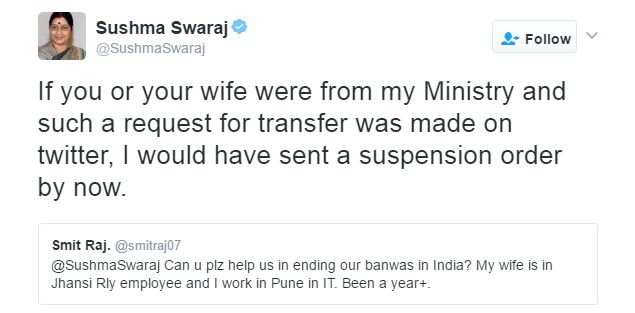On a recent tweetchat about customer service, many tweeples felt that social media was only suited for escalations.
Not me. I use social media, especially Twitter, as the first port of call to complain to brands.
That’s because:
- Telephone means having to listen to hold music and navigate through convoluted phone trees. This is painful and time-consuming.
- Website means trying to fit my problem to the list of boilerplate options available on the site – and mostly failing.
- On Twitter, I just need to find the brand’s handle and fire away my query, request or complaint.
- Maybe because no one likes their dirty laundry to be aired in public, brands respond to social media complaints quite fast. My problem is often solved on Twitter by the time I navigate a phone tree or select an option from a dropdown box to log a ticket via phone / website.
4 minutes. That's the fastest response I've EVER got from ANY brand to my complaint. Kudos to @RailMinIndia https://t.co/7LS8KjS1gs
— Ketharaman Swaminathan (@s_ketharaman) February 8, 2016
(I do admit that it was for escalation – to complain about the delays in getting my malfunctioning printer fixed – that I first used social media a few years ago.)
In short, social media, especially Twitter, is faster and more frictionless than telephone, website, mobile and the other traditional customer service channels. You can find more details in Customers Of The World Unite, You Have Nothing To Lose But The Call Center Hold Music.
I recently discovered another facet of social media customer service during a train journey from Pune to Tirupati (technically Renigunta). This has made social media my go-to channel more definitively than ever before. (For the uninitiated, Pune is a metropolitan city in West India and Tirupati is a temple town in South India.)
Soon after boarding the train at Pune, I found out that there was no water in the toilet.
Passengers inside the coach were complaining to the Train Ticket Examiner (TTE). For the uninitiated, the TTE is the seniormost-ranking railway official on an Indian train, with powers to check tickets, levy fines and accommodate passengers without reservation.
Flaunting his authority, the TTE pushed back with the excuse that he’d requested for filling water in the toilet at the previous station (Surat). He tried to shoo off the passengers saying that he couldn’t do anything more if the staff in Surat screwed up. In turn, the few bold ones among the passengers pointed out that it was his responsibility to get things done for passengers. To which the TTE shot back saying they had no right to tell him what his job was.
In short, this was yet another conversation between a citizen and an Indian public servant.
I realized that this was going nowhere and returned to my seat.
I vaguely recalled reading somewhere that Indian Railways provided support on Twitter. I Googled for the handle on my smartphone and sent out the following tweet:
@railminindia No water in 2nd AC coach:-( My PNR # is 8342517851. Can you please help? Train just left Pune.
— Ketharaman Swaminathan (@s_ketharaman) January 30, 2016
A few minutes later I got a reply:
@s_ketharaman Matter notified to the concerned officials @drmsolapur
— Ministry of Railways (@RailMinIndia) January 30, 2016
An hour or so later, the TTE came to me to explain the action he’d taken and assured me that watering would definitely happen at next stop (Solapur). (It did).
End of complaint.
And start of my ephiphany moment that there’s another angle to social media customer service that hadn’t caught my attention before.
I read about Indian Railways’ Twitter customer support department recently. According to Economic Times, the @RailMinIndia Twitter account is monitored at a central war room at Rail Bhawan in New Delhi. As soon as it receives a tweet from a passenger, the team at the war room goes into action. From the PNR number, it identifies the train, finds out where it is, maps its location to the railway division responsible for managing the train on that stretch and forwards the tweet to the Divisional Railway Manager (DRM) of that division. In parallel, someone calls up the TTE and the DRM to follow through on the tweet and tweets an acknowledgment back to the complaining passenger.
In my case, all of this happened in four minutes.
This is amazing, given the size of Indian Railways’ network and the federated manner in which the organization is run.
According to Wikipedia, Indian Railways runs 12617 passenger trains and 7421 freight trains daily across one of the world’s largest railway networks comprising 115000 km of track and 7112 stations. It’s administratively divided into 16 Zones, which are subdivided into 70 Divisions. Each Division is headed by a Divisional Railway Manager (DRM) (Source: Wikipedia). During its journey, a train traverses one or more zones and divisions. Depending upon where exactly it is at a given point in time, it comes under the administrative control of the Divisional Headquarters that has jurisdiction over the given stretch of track. For example, during my 960 kms journey, the train went through two zones (Central Railway and South Central Railway) and three divisions (Pune, Solapur and Guntakal).
But I digress.
After reading this article, it was clear that my tweet to @RailMinIndia had set off a sequence of events in the background that ended with a nudge to the TTE from his superbosses at Rail Bhawan. Not surprisingly, the same guy who was flexing his muscles with the other passengers took a very conciliatory approach with me.
I realized from this experience that social media upends traditional power equations and thereby changes the basic paradigm of customer service. It’s no longer the case of a hapless passenger trying to get heard by a supercillious public servant. Thanks to Twitter, the passenger has the whole might of the organization working for him or her.
This is easily visible with public sector organizations like Indian Railways. But, going by my first ever experience of using social media to get my printer repaired a few years ago, the channel empowers customers similarly even with private sector brands – just that it works behind the scene in those cases.
On a related note, any communication medium that becomes popular tends to get abused. Social media is no exception.
However, unlike other channels, the very open nature of social media can be used to discourage its frivolous use.
Whether organizations leverage social media to publicly name and shame offenders or not, the channel does have the built-in capability to curb abuse.
UPDATE DATED 6 FEB 2017:
 Now, even service providers want their customers to use social media as their first port of call for seeking customer service!
Now, even service providers want their customers to use social media as their first port of call for seeking customer service!
UPDATE DATED 29 DECEMBER 2021:
Four years after I wrote the above post, almost all brands I deal with provide customer service on Twitter. So the term “social media” can be conveniently replaced by “Twitter” in the body of the post, as I’ve already done in the title.

